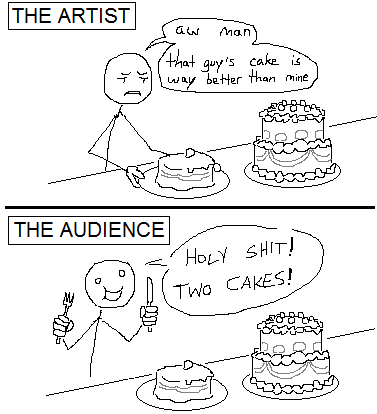Let me cite the bestselling author Someone On the Internet™ from their book “The Amateur’s Myths About Art in the Digital Age”:
“Do pixel art! It’s so much easier than other digital art”
“Publish your art on social media, you’ll get so much positive feedback“
“Just keep practicing and you’ll be successful“
Whether you’re an established pixel artist or just getting started, there’s a good chance you have either given or been given advice like this. I certainly have, and it has cost me lots of time and effort to “unlearn” most of it. It’s not exactly wrong advice but it leaves out so many fundamental details and nuances that it can be misleading. In this post I want to give you some insights I’ve gathered throughout the years; the things I wish I knew before starting pixel art.
1. A new artist is still an artist
What I thought: Artists are skilled professionals. Maybe one fine day I’ll be one of them.
What I learned: If you create art you’re an artist. Period.
If there’s just one thing you take away from this post, let it be this: An artist is someone who creates art. You might be a bad artist, a hobby artist, an art-blocked artist, a lazy artist, a new artist or a young artist but the moment you put a pixel on a canvas, you are an artist. You are one of us. Welcome to the club! Because art is a journey, not a goal. Each of us continue to learn with every artwork we make and for every nicely done painting that you see there’s an equal amount of weirdly shaped limbs or trees that look like metal poles. We’ve all started somewhere…
2. Tutorials are mostly ineffective
What I thought: I have to learn all the art fundamentals first.
What I learned: Practice beats theory every. single. time.
You’re feeling inspired, you’re feeling motivated and you’re eager to start drawing. But wait. Shouldn’t you better prepare? Shouldn’t you first learn about colour theory, composition and anatomy to catch up with all the other skilled artists you’re following? If for the past hour you’ve been browsing tutorial after tutorial and you haven’t even put a single pixel on the canvas yet: stop.
Just like watching a documentary about quantum physics won’t make you a physicist, watching tutorials won’t magically boost your art skills. (Spoiler: reading this blog post won’t do that either.) Especially when you’re just starting out, the tiniest fraction of all the information will stick. Whatever you want to draw: find some photo references and just draw it.
You say your trees look like rusted metal? Ok, now may be the time for a tree tutorial. Pick one to unblock you and then get back to drawing. Be honest with yourself: are you learning something or is it pure entertainment, killing time?
3. The "Taste Gap" is useful
What I thought: Everyone’s their own worst critic.
What I learned: Spotting flaws is a skill that helps improving.
Chances are that your first artworks don’t match what you envisioned. Worse even, you might dislike them. This is sometimes referred to as the “taste gap”. Some days, it will drag you down but look at it like this: Only when you recognise issues in your artworks can you meaningfully improve on them. Just imagine being absolutely happy with your work – you’d be stuck with your current skill level, forever.
In case you think it’s just a phase: it’s not, haha. I’m yet to meet an artist who can’t immediately point out things that bother them in their artworks, no matter how absurdly skilled they might seem. However, don’t dwell on mistakes! Acknowledge your achievements and regularly revisit your older works to see some evidence of how much you’ve grown and improved.
4. Pixel Art is hard
What I thought: Pixel art is easier than other digital art.
What I learned: It’s equally hard, if not actually harder.
With many pixel artworks having a seemingly cute look in extremely low resolutions, you might think “how hard could it be to place pixels on a 32×32 canvas”? Turns out it’s extremely difficult. In regular digital art, getting the overall shapes right is usually enough but in pixel art sometimes even shifting a single pixel can produce a very different result. No matter the medium, all the art fundamentals (colour theory, composition and anatomy) continue to apply.
The good thing about pixel art is that mistakes can be corrected without leaving a trace. If your process involves a lot of trial and error (as mine certainly does), you’ll love the forgiving nature of pixel art. At the end of the day, your skills – not the medium – define the outcome!
5. references are not cheating
What I thought: Real artists don’t use references.
What I learned: Not making use of references is dumb.
There is a myth on the internet that claims using references was a means of cheating and it couldn’t be further from the truth. It is true that the more you practice the more muscle memory you’ll develop when it comes to drawing proportions, objects and lighting but you should always use (multiple) references to observe shapes, to learn patterns and to really nail the essence of that thing you’re trying to draw.
The important caveat: references do not mean copying! Resist the temptation to copy and paste something into your artwork or to mimic another artist’s style exactly. As a rule of thumb: if you find yourself mindlessly replicating the reference, then you’re probably not making effective use of it.
6. Social Media is relentless
What I thought: Everyone’s getting tons of praise for their artworks!
What I learned: Prepare for unsolicited advice and unfounded critique.
I have to admit that part of me wanted to start posting my pixel art for the immense positive feedback that the artists seemed to receive online. Today I can only shake my head in pity for my naive past self. If you closely examine comments on social media you’ll notice that most of the time the statements remain rather shallow: “Awesome!” and “Wow, you’re so talented!” definitely lift an artist’s mood but they’re not what will keep you motivated long-term.
As a viewer you might glance over negative comments and be quick to discard them. As an artist, you likely won’t. Especially when you just proudly published that artwork on which you spent the entire weekend. People will critisise it, will tell you things you should add, change or remove, and sometimes be just outright hostile for no reason whatsoever. Be prepared for it and don’t take it personally.
7. Accepting Feedback is optional
What I thought: Discarding feedback is arrogant.
What I learned: Opinions won’t help to improve.
The most important skill for anyone offering (and receiving) art critique is to distinguish between opinion, taste and constructive feedback. As a general rule: be aware of what your intention is behind the way you draw something and then pick and choose the feedback that helps you improve. For example, if your intention was to put focus on an object in a larger scene but your choice of colours makes the object hard to see, then pointing this out to you would be valid critique. If you intentionally wanted to let the object blend into the environment, though, it would be completely unjustified.
Very rarely will people ask to understand your intentions first before offering feedback but if they do, you can be sure they genuinely want you to improve and not just shout out their opinion. In any case: You’re always free to just not listen. This is your art and your journey and there’s no unwritten law that every artist has to continuously focus on improvement and optimisation.
8. Community is everything
What I thought: I’m just a n00b and nobody cares about my opinion.
What I learned: Giving feedback to others helps me improve.
You can of course just enjoy the artworks of your fellow artists but I highly encourage you to take the above paragraph about feedback and every once in a while engage with your peers to give them meaningful feedback on their art. It’s extremely rare to receive well thought-out critique, so they’ll surely appreciate it and if you’re lucky, they might even return the favour. Just the mere act of asking someone for advice lets them know that you value their input. It’s just a fun and constructive way of joining the community.
The best part about it is that it will sharpen your senses as well. Somehow it’s easier to spot flaws in other people’s artworks than in your own ones but after some time you’ll start noticing those rogue pixels when you encounter them.
9. It's not only about the art
What I thought: People just care about the art.
What I learned: Inspiring others is the most rewarding thing.
Ok, this is taking a weird business-y turn now but hear me out: There are different personas in your audience and understanding what they crave for will help you build meaningful relationships with them. Some are curious to peek behind the curtains, some are artists themselves and looking to learn and collaborate and others love to be surrounded by the vibrant art community for inspiration.
Apart from posting my art, one of my most widely liked and shared tweets was me disclosing that I started making art at the age of 30. I got a lot of comments from others who felt encouraged, inspired and motivated to start making art themselves (but felt they were too old) and I still tear up a little bit when I imagine that someone might sit down and happily draw awesome stuff right now because of my tiny tweet. It’s not all just about the art and I can only encourage you to open up and invite others to join you on your journey.
10. Success is not a scarce resource
What I thought: (severe envy that cannot be put into words)
What I learned: Succeeding together feels better than struggling alone.
Full disclosure: during the first months of my pixel art career, I used to sometimes not hit the “like” button when I felt that the artist already had “enough” likes or I’d not share their art when I was anxious about my audience moving over to their account because it was so much better than mine. What a spiteful, terrible human being I was, huh?
This was entirely due to insecurity and the fear that this was all a competition for a limited amount of attention from the audience. To which I can only reply with this comic, which sums it up better than I could put into words

Even if you have just 20 followers, a fellow artist just starting out on social media will hugely appreciate your support. No matter how big a following an artist has, they’ll always blush for you complimenting them on the feature of their artwork they secretly struggled with. If anything, supporting fellow artists will earn you their support as well. Let’s root for each other as hard as we can. Because this world deserves more cake. And pixels.

